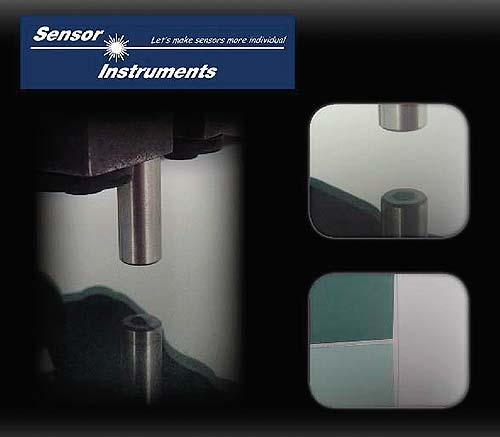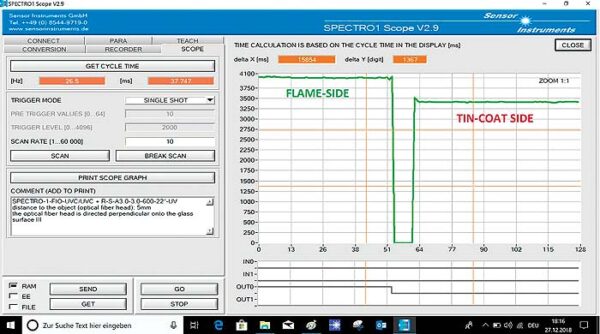 95% of all the industrially produced flat glass today is made using the float glass process. In this process, molten glass is continuously fed into a bath of molten tin. Due to its lower specific weight the molten glass floats on the smooth tin surface, and on a long tin bath forms a uniformly thick and extremely smooth film.
95% of all the industrially produced flat glass today is made using the float glass process. In this process, molten glass is continuously fed into a bath of molten tin. Due to its lower specific weight the molten glass floats on the smooth tin surface, and on a long tin bath forms a uniformly thick and extremely smooth film.
 The glass side that faces the molten tin is slightly contaminated with tin, which has corresponding effects on subsequent float glass processing steps such as coating of the glass surface. For the further processing of float glass it is therefore important that the surface that is contaminated by the tin bath can be distinguished from the so-called fire side (fire polishing, during float glass production the glass side facing away from the molten tin is heated). According to experience the float glass surface facing the tin bath shows a clearly reduced optical direct reflection in the UVC wavelength range. With a contrast sensor of type SPECTRO-1-FIO-UVC/UVC and quartz-glass reflective fibre optics R-S-A3.0-(3.0)-600-22°- UV the tin side due to its reduced light reflection without any problems can be distinguished from the fire side, irrespective of whether the float glass is tinted, highly tinted, or not colored at all. The fibre optics frontend is vertically directed onto the respective glass surface at a distance of 5mm. Extraneous light influences are prevented by means of pulsed light and correspondingly adapted optical filters. Due to its non-contacting measuring method the system also is suitable for inline applications. For offline use a suitable fibre optics mount is available.
The glass side that faces the molten tin is slightly contaminated with tin, which has corresponding effects on subsequent float glass processing steps such as coating of the glass surface. For the further processing of float glass it is therefore important that the surface that is contaminated by the tin bath can be distinguished from the so-called fire side (fire polishing, during float glass production the glass side facing away from the molten tin is heated). According to experience the float glass surface facing the tin bath shows a clearly reduced optical direct reflection in the UVC wavelength range. With a contrast sensor of type SPECTRO-1-FIO-UVC/UVC and quartz-glass reflective fibre optics R-S-A3.0-(3.0)-600-22°- UV the tin side due to its reduced light reflection without any problems can be distinguished from the fire side, irrespective of whether the float glass is tinted, highly tinted, or not colored at all. The fibre optics frontend is vertically directed onto the respective glass surface at a distance of 5mm. Extraneous light influences are prevented by means of pulsed light and correspondingly adapted optical filters. Due to its non-contacting measuring method the system also is suitable for inline applications. For offline use a suitable fibre optics mount is available.
https://www.oboyle.ro


